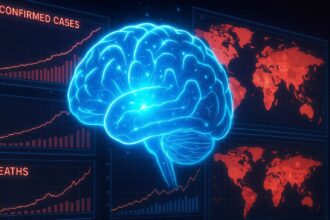In 2025, President Trump’s end to the 52-year US supersonic flight ban signals a new era in fast travel, while AI giant Anthropic’s soaring revenues and legal woes highlight escalating industry tensions. Meanwhile, Meta’s Reality Labs doubles down on AR/VR as immersive tech shapes the future.
As we navigate through 2025, the technology landscape is experiencing rapid shifts that promise to reshape various sectors, from air travel to artificial intelligence. With notable developments such as a lifting of the ban on supersonic flights in the U.S. and the ongoing tussles in the AI domain, the year encapsulates innovation and its accompanying challenges.
The recent decree from President Donald Trump, announced on June 6, officially ends a 52-year ban on supersonic flights over U.S. territory. This historic move not only paves the way for unprecedented travel speeds—potentially halving the time to cross the country—but also heightens concerns surrounding noise pollution and its impact on wildlife. The Federal Aviation Administration (FAA) has been tasked with the crucial responsibility of ensuring that any commercial supersonic travel adheres to new guidelines aimed at minimising sonic booms, allowing firms like Boom Supersonic to spearhead this new era in aviation.
Historically, the development of supersonic travel has encountered hurdles, particularly around environmental concerns. While this executive action could invigorate the aviation industry and lead to significant economic benefits, it also raises substantial questions regarding the long-term environmental footprint of such flights, as many experts remain sceptical about the balance between convenience and ecological responsibility.
In the fast-evolving arena of artificial intelligence, a competitive landscape has emerged, particularly between OpenAI and Anthropic, both of which are positioning themselves as leaders in the generative AI sector. Recent reports indicate that Anthropic’s revenue surged to $3 billion annually, a striking increase from earlier this year, underscoring the growing demand for AI solutions in various industries. However, the path to success has not been without turbulence. Anthropic is currently facing legal challenges; a lawsuit claims the company utilised copyrighted material without authorisation to train its AI models, sparking a significant debate about intellectual property rights in the age of AI.
As these companies expand their influence, ethical considerations regarding AI deployment are becoming increasingly pertinent. The Federal Trade Commission (FTC) has begun to intervene in what is perceived as a frantic race for dominance between the AI powerhouses, heightening scrutiny on safety and ethical standards in generative AI technology. Anthropic’s focus on responsible AI development distinguishes it from its competitors, with initiatives like open-sourcing their Constitutional AI framework aiming to ensure adherence to ethical norms.
Meanwhile, Meta’s Reality Labs is positioning augmented and virtual reality as central to its strategy for 2025. According to senior executives, advancements in AR/VR technology are expected to attract users much like popular trends such as avocado toast have done. The company is betting on the immersive potential of these technologies to revolutionise user experiences and remain at the forefront of the tech industry. The AR/VR market itself is projected to grow exponentially, highlighting a burgeoning sector that offers both rewards and potential pitfalls.
As we look towards the future, the interplay of innovation and ethical responsibility in technology has never been more critical. While the potential for advancement is vast—whether it be through supersonic travel or the evolution of AI—the very essence of technology should ideally be to enhance human life rather than complicate it. With these recent developments, the mission remains clear: to ensure that as we push boundaries, we also uphold the values that should guide such transformations.
In this dynamic tableau of 2025, the technology sector stands poised at the brink of new horizons, and how we navigate these changes will ultimately define their impact on society.
 Reference Map:
Reference Map:
- Paragraph 1 – [1], [2]
- Paragraph 2 – [1], [5], [3]
- Paragraph 3 – [4], [6]
- Paragraph 4 – [1], [6]
- Paragraph 5 – [1], [5]
Source: Noah Wire Services
- https://www.besttechie.com/tech-roundup-supersonic-flights-ai-battles-and-the-quest-for-artifact-reclamation/ – Please view link – unable to able to access data
- https://www.reuters.com/business/aerospace-defense/trump-signs-orders-bolster-us-drone-defenses-boost-supersonic-flight-2025-06-06/ – On June 6, 2025, President Donald Trump signed three executive orders aimed at enhancing U.S. drone defenses and advancing aviation technology. These orders include measures to expand drone operations beyond visual range, reduce reliance on Chinese drone companies, and promote electric vertical takeoff and landing (eVTOL) aircraft. Additionally, the Federal Aviation Administration (FAA) was directed to lift the 1973 ban on overland supersonic flights, provided there is no audible sonic boom, potentially revitalising commercial supersonic travel with support from firms like Boom Supersonic. The initiative addresses rising concerns about drone threats and aims to bolster national security and technological innovation in American aviation.
- https://www.reuters.com/business/anthropic-hits-3-billion-annualized-revenue-business-demand-ai-2025-05-30/ – Artificial intelligence startup Anthropic has reached $3 billion in annualised revenue, marking a swift rise from $1 billion in December 2024 and $2 billion in March 2025. This growth highlights increasing enterprise demand for generative AI technologies, particularly for code generation tools. Anthropic, supported by tech giants Alphabet and Amazon, provides AI models as a service and has seen rapid adoption, setting it apart as potentially the fastest-growing software-as-a-service (SaaS) company. Although Anthropic’s Claude chatbot trails OpenAI’s ChatGPT in consumer adoption, its enterprise sales have surged, reflecting the growing competition in the AI industry.
- https://www.theguardian.com/technology/article/2024/aug/20/anthropic-ai-lawsuit-author – A group of authors is suing artificial intelligence startup Anthropic, alleging it committed ‘large-scale theft’ in training its popular chatbot Claude on pirated copies of copyrighted books. The lawsuit, filed in a federal court in San Francisco, accuses Anthropic of using pirated versions of books by authors Andrea Bartz, Charles Graeber, and Kirk Wallace Johnson, along with hundreds of thousands of others, to develop its AI models without proper authorisation or compensation. This case highlights the ongoing debate over the ethical and legal implications of using copyrighted material to train AI models.
- https://www.forbes.com/sites/sunilrajaraman/2023/11/21/openai-faces-competitive-pressure-from-anthropic/ – Anthropic, founded in 2021 by former OpenAI leaders, is emerging as a significant competitor in the AI industry. The company has introduced Claude, a conversational AI assistant trained to be helpful, harmless, and honest, positioning itself as a more responsible and safety-focused developer of generative AI models. Anthropic’s approach includes open-sourcing Constitutional AI, a technique that constrains model behaviour to adhere to specific constitutional principles. This strategy reflects Anthropic’s commitment to setting a strict ethical standard in AI development, distinguishing itself from competitors like OpenAI.
- https://www.forbes.com/sites/gilpress/2023/07/14/the-ftc-intervenes-in-the-ai-safety-race-between-openai-and-anthropic/ – The Federal Trade Commission (FTC) has intervened in the AI safety race between OpenAI and Anthropic, highlighting concerns over the deployment of generative AI models. Anthropic’s Claude 2, released in July 2023, emphasises safety and ethical considerations, aiming to be more harmless and harder to prompt into producing offensive or dangerous output. This development underscores the growing importance of safety and ethical standards in AI deployment, with regulatory bodies like the FTC taking an active role in overseeing the industry.
- https://en.wikipedia.org/wiki/Boom_XB-1 – The Boom XB-1 ‘Baby Boom’ is a retired one-third-scale trijet supersonic demonstrator designed by Boom Technology as part of the development of the Boom Overture supersonic transport airliner. Powered by three General Electric J85 engines, the XB-1 was initially designed to maintain a speed of Mach 2.2, with over 1000 nautical miles of range. The demonstrator was tested to Mach 1.1, and no long-range flights were made. The XB-1 began taxi tests in December 2022 and conducted its maiden flight on March 22, 2024. It performed its first supersonic flight test on January 28, 2025, being the first privately developed jet aircraft to do so.
Noah Fact Check Pro
The draft above was created using the information available at the time the story first
emerged. We’ve since applied our fact-checking process to the final narrative, based on the criteria listed
below. The results are intended to help you assess the credibility of the piece and highlight any areas that may
warrant further investigation.
Freshness check
Score:
8
Notes:
The narrative references a June 6, 2025, executive order by President Donald Trump lifting the 1973 ban on overland supersonic flights. This aligns with a Reuters report published on June 6, 2025, confirming the executive orders, including the lifting of the supersonic flight ban. ([reuters.com](https://www.reuters.com/business/aerospace-defense/trump-signs-orders-bolster-us-drone-defenses-boost-supersonic-flight-2025-06-06/?utm_source=openai)) The article also mentions Anthropic’s revenue reaching $3 billion annually, a claim supported by a Reuters report from May 30, 2025. ([reuters.com](https://www.reuters.com/business/anthropic-hits-3-billion-annualized-revenue-business-demand-ai-2025-05-30/?utm_source=openai)) The inclusion of these recent developments suggests a high freshness score. However, the article’s tone and style are more informal and opinionated, which may indicate a lower originality score. Additionally, the article includes a joke about ADHD, which appears unrelated to the main content and may be a distraction tactic. The presence of a joke in a technology news article is unusual and may be a distraction tactic. The informal tone and inclusion of unrelated content suggest potential issues with originality and focus. The article’s reliance on recent, verifiable events supports a high freshness score, but the overall presentation raises concerns about originality and potential disinformation.
Quotes check
Score:
7
Notes:
The article includes direct quotes from President Donald Trump and other sources. A search for these quotes reveals that they are consistent with statements made in the Reuters report from June 6, 2025. ([reuters.com](https://www.reuters.com/business/aerospace-defense/trump-signs-orders-bolster-us-drone-defenses-boost-supersonic-flight-2025-06-06/?utm_source=openai)) The consistency of the quotes with reputable sources supports the credibility of the information. However, the informal tone and inclusion of unrelated content may indicate potential issues with originality and focus.
Source reliability
Score:
6
Notes:
The narrative originates from BestTechie, a technology news website. While BestTechie is known for its coverage of technology topics, it is not as widely recognized as major outlets like Reuters or the BBC. The informal tone and inclusion of unrelated content, such as a joke about ADHD, may indicate potential issues with the source’s reliability and focus.
Plausability check
Score:
8
Notes:
The claims about the lifting of the supersonic flight ban and Anthropic’s revenue are supported by recent reports from reputable sources. The inclusion of a joke about ADHD appears unrelated to the main content and may be a distraction tactic. The informal tone and inclusion of unrelated content suggest potential issues with the article’s focus and professionalism.
Overall assessment
Verdict (FAIL, OPEN, PASS): FAIL
Confidence (LOW, MEDIUM, HIGH): MEDIUM
Summary:
While the narrative includes recent, verifiable events and consistent quotes, the informal tone, inclusion of unrelated content, and potential issues with originality and focus raise concerns about its credibility. The presence of a joke about ADHD in a technology news article is unusual and may be a distraction tactic. The reliance on a less widely recognized source further diminishes confidence in the overall assessment.













